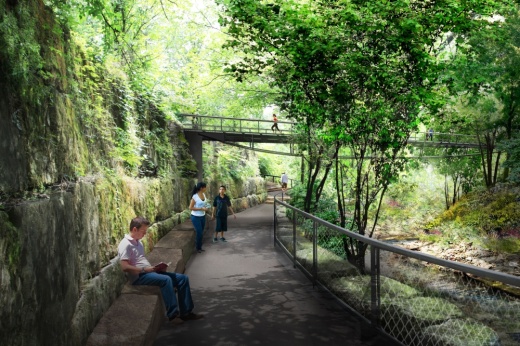Waller Creek Local Government Corporation chose its preferred developer for the second phase, Jay-Reese Contractors, on Jan. 18. The company has already worked on several local projects, including the Pfluger Bridge, Boardwalk Trail at Lady Bird Lake and Second Street Bridge.
The second phase, called The Confluence, will extend from Fourth Street to Lady Bird Lake. The trail system will meander through a “cultural epicenter” of Austin, as it will sit next to Palm Park, the Rainey Street Historic District, the Emma S. Barrientos Mexican American Cultural Center, the Austin Convention Center, Brush Square Park, and the Butler Hike and Bike Trail.
Project work includes reconstructing a creek channel to stabilize severely eroded slopes, building creek features that create habitats for wildlife, introducing native plants and trees along the riparian corridor, adding inline stormwater treatment devices, and adding a biofiltration pond—a pond that is kept clean using a biofilter that removes pollutants, according to Waterloo Greenway.
New trails and bridges will also be constructed, including over a dozen connections to existing sidewalks and trails and 800 feet of boardwalk just above the water surface, said John Rigdon, director of planning and design for Waterloo Greenway.
“This phase will include over a mile of universally accessible trails along Waller Creek,” Rigdon said. “Once complete, a visitor will be able to walk or bike from Fourth Street to Lady Bird Lake without ever having to interact with vehicular traffic.”
Construction is slated to begin spring 2023 and last two to three years. Jay-Reese will develop a schedule and construction plan and review it with the city of Austin and Waterloo Greenway.
When Phase 2 is finished, nearly 1,550 trees, 200,000 mature plants and 10 acres of seed mixes will have been added to the landscape, making it the most ecologically diverse section of Waller Creek, according to Waterloo Greenway.
The added greenery will improve downtown air quality, improve creek health, mitigate greenhouse gas emissions and reduce the urban heat island effect—a phenomenon that occurs when cities, like Austin, have dense concentrations of pavement, buildings and other surfaces that absorb and retain heat, according to Waterloo Greenway.
The over $75 million project has received funding from several avenues, including $9 million in federal funding from the U.S. Army Corps of Engineers, and over $50 million in funding from multiple city of Austin departments, including Watershed Protection, Parks and Recreation, Development Services, Austin Energy, Convention Center and Austin Water.
Waterloo Greenway Conservancy has gathered over $12 million in funding and has a goal of reaching $13 million for Phase 2. The conservancy has a total of $38 million left to raise to complete design and construction of the full park project.
Waterloo Greenway Conservancy is working to connect 35 acres of green space in downtown Austin in three phases. The first phase—completed in August 2021—delivered Waterloo Park and the Moody Amphitheater, and made improvements to Symphony Square. During construction of Phase 1, staff added 90,000 plants to Waterloo Park, 95% of them native to Austin, and replanted eight heritage live oak trees for shade.
Waterloo Greenway Conservancy’s third phase—Palm Park and the Refuge—will stretch from Third Street to 11th Street, connecting the first and second phases together.





